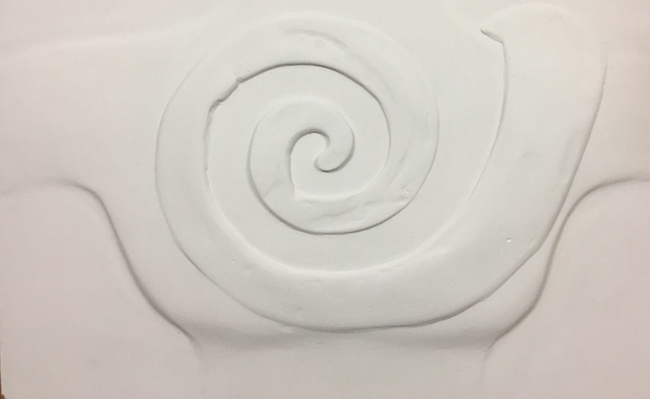L’arte contemporanea tende spesso a protendersi velocemente verso il futuro, osservando la modernità e cercando di descriverla nelle sue pieghe più destabilizzanti, complicate e a volte alienanti, talmente tanto concentrata sul domani da dimenticare di guardare indietro verso quello ieri più o meno remoto che ha costituito le basi per ciò che l’essere umano è riuscito gradualmente a ottenere, evolvendosi fino a giungere al momento presente. Esistono però artisti che hanno il bisogno di tendere la mano a quel passato arcaico, superato eppure vicino per tematiche e tendenza dell’uomo a una conoscenza che malgrado tutto continua a sfuggirgli, oggi come ieri. La protagonista di oggi crea un suo particolare linguaggio espressivo che si trasforma in ponte tra ciò che gli avi primitivi hanno tracciato e la rielaborazione delle questioni universali che sussistono anche nella società contemporanea.
Fin dai primordi della civiltà l’uomo ha avvertito l’esigenza di misurarsi con un’espressione artistica, che in quell’epoca remota era considerata forma di linguaggio poiché la parola era ancora distante dall’essere elaborata, per lasciare un segno del passaggio di una famiglia, una tribù, testimoniando di fatto scene di vita, di caccia, di quotidianità, sotto forma di segni semplici ma rappresentativi; questo tipo di iscrizione grafica prese il nome di graffito, inteso nel senso più antico del termine poiché veniva inciso graffiando letteralmente la roccia delle caverne che rimanevano effigiate con quelle immagini primordiali destinate ad affascinare studiosi e archeologi. Il cammino verso la civiltà così come conosciuta oggi è stato lento e ha implicato riflessioni e trasformazioni in cui l’uomo si è messo al centro di un percorso introspettivo inizialmente affidandosi a forze esterne, come tutte le religioni politeiste in cui ogni qualità era protetta da una divinità, e poi continuando a cercare un dialogo diretto con tutto ciò che poteva dare risposta all’inconoscibilità dei misteri dell’esistenza, alla vita, alla morte, al passaggio dell’uomo sulla terra, alla giustizia, agli elementi della natura. Tutto questo si legò indissolubilmente a uno stile espressivo ancora acerbo ma tuttavia efficace proprio per la sua spontaneità, per la capacità di arrivare al popolo che doveva gettare le basi delle future civiltà; i materiali usati erano ugualmente affini a quella naturalezza di cui l’uomo aveva bisogno per comprendere qualcosa di complicato, di inarrivabile se non affidandosi a un intervento superiore. Nel corso della storia dell’arte del Novecento questo tipo di atteggiamento introspettivo contraddistinse una parte dell’Espressionismo, tutto il Surrealismo e la Metafisica, l’Arte Informale in cui però la ricerca era più orientata all’ascolto del proprio essere, della propria interiorità, abbandonando pertanto quella necessità di lasciar emergere le grandi domande universali che l’uomo da sempre si pone per concentrarsi sulla conoscenza socratica del proprio essere, della propria vera sostanza che come tale doveva giungere all’osservatore. Nel contempo però vi furono invece artisti che attinsero dall’arte preistorica per dar vita al loro personale e singolare stile pittorico come Keith Haring e A. R. Penk, entrambi appartenenti alla Street Art, che stilizzarono la figura umana rielaborando quella primordiale delle civiltà preletterate, Yves Klein che con le Antropometrie, risultati della sua Body Art, diede vita a forme umane semplificate riconducibili a quelle dei graffiti, così come tutta la Brut Art che andò e va verso la medesima direzione. L’artista calabrese Rosella Cerra si lega al graffitismo e al linguaggio diretto e spontaneo delle incisioni antiche attraverso un Informale Materico che diviene mezzo per continuare a esplorare significati mai realmente svelati, in virtù di quella forza di interazione con tutto ciò che è esterno alla bidimensionalità, come se proprio quel protendersi contribuisse a rendere necessaria la ricerca di una risposta.
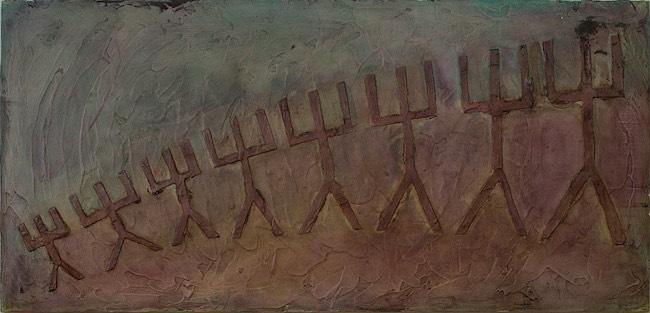
Dunque la sua analisi si sposta da se stessa, dal proprio intimo sentire, che invece aveva contraddistinto l’Arte Informale, per giungere a un’apertura verso i temi fondamentali, quegli stessi che erano stati affidati in passato alle divinità dei culti politeisti e che in fondo hanno cercato di mettere l’uomo e il suo contatto con l’Universo al centro del loro credo. I materiali usati da Rosella Cerra sono il legno, gli stucchi, le incisioni che vanno a dare rilevanza ai dettagli per lei essenziali e funzionali a mettere in evidenza ciò che di volta in volta prova a essere spiegato; le figure utilizzate per compiere questo percorso di conoscenza, sono le medesime delle ancestrali iscrizioni rupestri, forse perché l’artista desidera sottolineare quanto, nonostante il trascorrere dei secoli, l’essenza della vita, il cammino dell’umanità, i misteri più profondi restano immutati, così come resta invariato il desiderio dell’uomo di avvicinarsi a essi per risolverli.
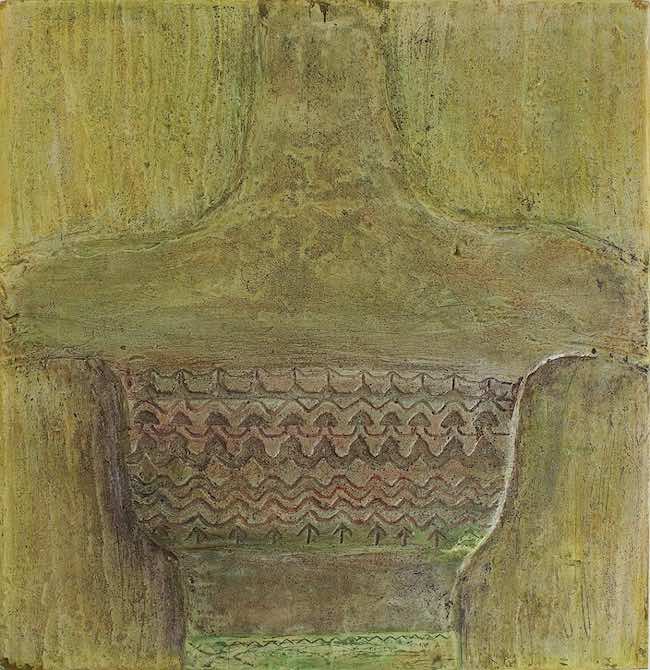
Eppure il fatto stesso di continuare a confrontarsi con queste tematiche eleva l’essere umano e lo tende a quella costante evoluzione che contraddistingue la sua stessa natura, al volersi superare per raggiungere livelli migliori, più evoluti, più vicini a quell’ignoto che forse non avrà mai una spiegazione se non quella di stimolare l’impulso conoscitivo.
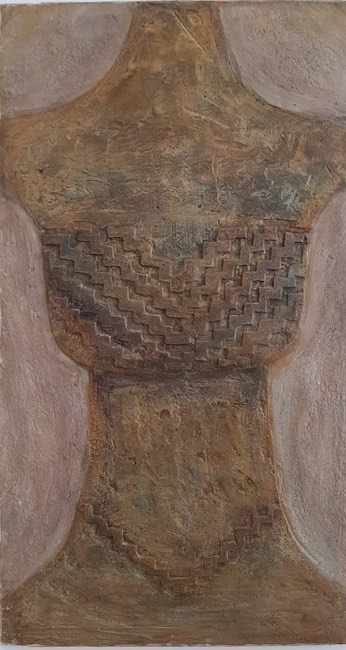
Attraverso il suo tocco materico Rosella Cerra affronta le tematiche esistenziali, mette a confronto il punto di vista attuale con quello del passato, sottolineando quanto esso sia scrigno di conoscenza, di certezze consolidate, di conservazione di tutto ciò che ha costituito una radice e anche ciò che è rimasto nel perenne dubbio, nel costante bisogno di esplorare l’inconoscibile.
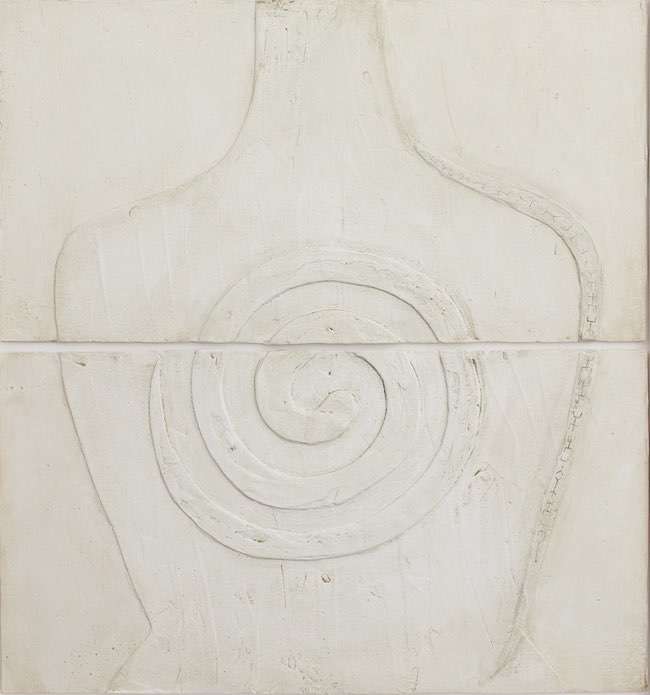
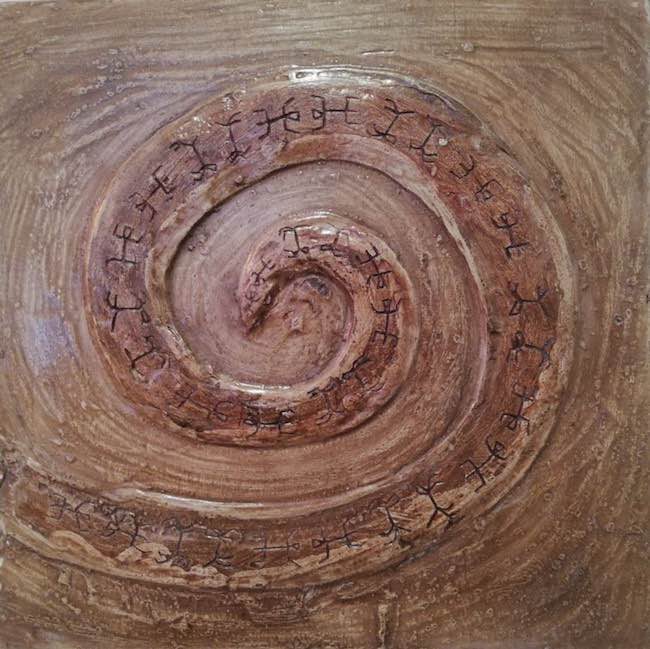
La spirale è un tema piuttosto ricorrente, e caro all’artista, poiché simboleggia l’energia, la fecondità, ma rappresenta anche lo sviluppo del cosmo partendo dal centro, dunque l’espandersi della coscienza creativa che dà origine a tutte le cose; pertanto il mistero che sembra avvolgere opere come Eva mitocondriale con il peso dell’Umanità o Viaggio sulla spirale nell’Universo, in stucco bianco la prima e in legno ricoperto da stucco intagliato e caratterizzata da colori terrosi la seconda, racconta in fondo di quella naturale espansione energetica verso l’esterno, verso uno sviluppo naturale sia del singolo individuo che della collettività. Mentre nell’opera bianca l’atmosfera è avvolta dal silenzio come se la Cerra mettesse a fuoco il concetto di una figura materna, quella di Eva che ha di fatto dato la vita all’intera umanità, e quello della polarità della creazione, la consapevolezza di generare una dualità nella natura e la sua innata ricerca di equilibrio tra il bene e il male, nell’opera color terra l’artista incide una stilizzazione dell’uomo, come se il trovarsi all’interno del vortice rappresentasse il cammino intrapreso fin dagli esordi dell’umanità e poi allontanatosi sia in senso temporale che figurativo, alla ricerca di un’identità troppo spesso perduta nella società contemporanea. Rosella Cerra sembra suggerire che la strada per vivere il presente è forse proprio quella di ricongiungersi con il passato, andare a ricercare quelle origini dimenticate che permettono però di non dimenticare quanto tutto fosse più semplice, più puro anche, in quel tempo remoto ma molto più legato alla naturalezza e alla spontaneità.
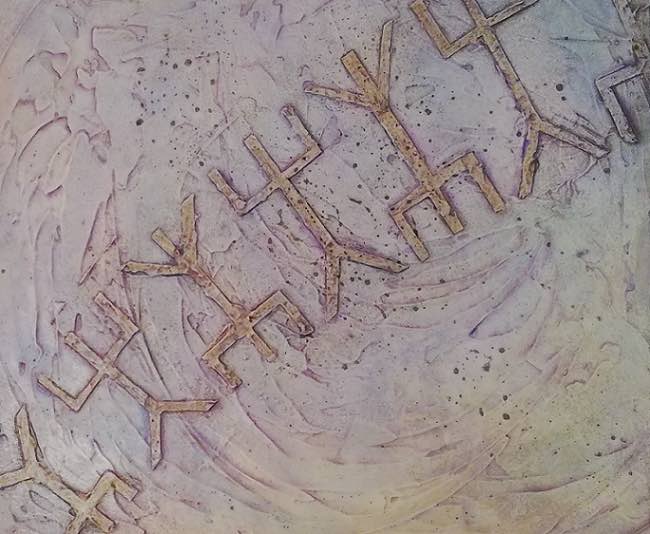
Il concetto di umanità, del percorso intrapreso e mai interrotto verso il progresso, la conoscenza, l’elevazione a un livello superiore è ripreso anche nell’opera Umanità in viaggio in cui la figura stilizzata dell’uomo non è più intagliata bensì scolpita in bassorilievo, dando così vita a una pittoscultura in cui lo sfondo ruvido e consistente appare come base di un percorso a volte accidentato, mai semplice perché mai lo è il viaggio verso la conoscenza e verso l’esperienza che condurrà solo dopo alla creazione di un mondo migliore.
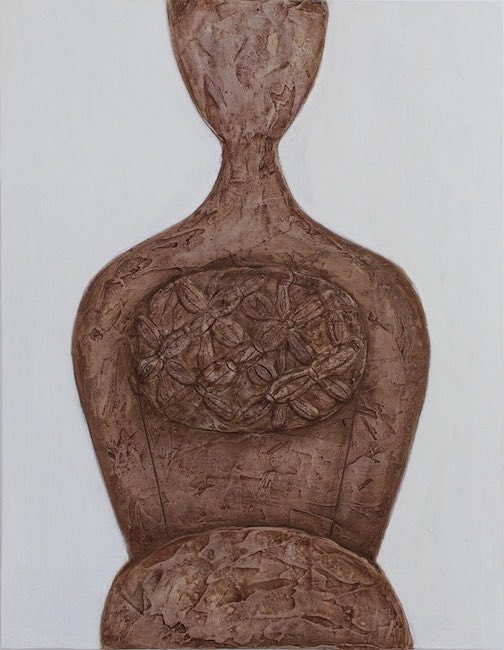
Anche il tema della donna è centrale nell’espressione artistica di Rosella Cerra, al punto di dedicarle un’intera serie, Le sette figlie di Eva, che esplora la teoria secondo la quale l’intera umanità discende da una di loro e dunque non ha senso pensare a divisioni e distinzioni sulla base della razza poiché all’origine non esisteva; le pittosculture sono tutte in stucco su legno e contraddistinte dalla mancanza del volto, perché in fondo ciò che conta è l’essenza, la capacità di generare la vita, ieri come oggi. Rosella Cerra ha all’attivo molte mostre collettive e personali a Roma, Firenze, Catanzaro e Lamezia Terme, ha realizzato murales per istituzioni pubbliche e ha in esposizione permanente presso le sale del Comune di Lamezia un suo polittico.
ROSELLA CERRA-CONTATTI
Email: rosella.cerra@gmail.com
Facebook: https://www.facebook.com/rosella.cerra
The bridge between old and new in Rosella Cerra’s Materic Informal, so as not to forget the origins of culture
Contemporary art often tends to quickly lean towards the future, observing modernity and trying to describe it in its most destabilising, complicated and sometimes alienating folds, so focused on tomorrow that it forgets to look back towards that more or less remote yesterday that formed the basis for what human beings have gradually managed to achieve, evolving to the present moment. There are, however, artists who have the need to reach out to that archaic past, outdated and yet close in terms of themes and man’s tendency towards a knowledge that despite everything continues to elude him, today as yesterday. Today’s protagonist creates her own particular expressive language that becomes a bridge between what the primitive ancestors traced and the reworking of universal issues that also exist in contemporary society.
From the very beginnings of civilisation, man has felt the need to measure himself against an artistic expression, which in those remote times was considered a form of language since the word was still far from being elaborated, in order to leave a mark of the passage of a family, a tribe, bearing witness to scenes of life, hunting, everyday life, in the form of simple but representative signs; this type of graphic inscription took the name of graffito, intended in the most ancient sense of the term, since it was engraved by literally scratching the rock of the caves that were left with those primordial images destined to fascinate scholars and archaeologists. The path to civilisation as we know it today was slow and involved reflection and transformations in which man placed himself at the centre of an introspective journey, initially relying on external forces, like all polytheistic religions in which every quality was protected by a deity, and then continuing to seek a direct dialogue with everything that could provide an answer to the unknowability of the mysteries of existence, life, death, the passage of man on earth, justice, and the elements of nature. All this was inextricably bound up with an expressive style that was still immature but nevertheless effective precisely because of its spontaneity, its ability to reach the people who were to lay the foundations of future civilisations; the materials used were equally akin to that naturalness that man needed in order to understand something complicated, unattainable unless he relied on superior intervention.
Throughout the history of 20th century art, this kind of introspective attitude characterised a part of Expressionism, all of Surrealism and Metaphysical Art, and Informal Art, in which, however, the search was more oriented towards listening to one’s own being, to one’s own interiority, thus abandoning that need to let the great universal questions that man has always asked emerge in order to concentrate on the Socratic knowledge of one’s own being, of one’s own true substance, which as such had to reach the observer. At the same time, however, there were artists who drew on prehistoric art to give life to their personal and singular pictorial style, such as Keith Haring and A. R. Penk, both belonging to Street Art, who stylised the human figure by reworking the primordial figure of pre-literate civilisations, Yves Klein, who with Anthropometries, the results of his Body Art, gave life to simplified human forms that can be traced back to graffiti, as well as all Brut Art, which went and goes in the same direction. Calabrian artist Rosella Cerra links herself to graffiti art and the direct and spontaneous language of ancient engravings through a Materic Informal that becomes a means of continuing to explore meanings that have never really been revealed, by virtue of that force of interaction with everything that is outside of two-dimensionality, as if that very reaching out contributed to making the search for an answer necessary.
Thus, her analysis moves away from herself, from her own intimate feeling, which had instead characterised Informal Art, to reach an openness towards fundamental themes, the same ones that had been entrusted in the past to the divinities of polytheistic cults and that basically sought to put man and his contact with the Universe at the centre of their creed. The materials used by Rosella Cerra are wood, stucco, and engravings that give prominence to the details that are essential and functional for her to highlight what is trying to be explained from time to time; the figures used to accomplish this path of knowledge are the same as the ancestral rock inscriptions, perhaps because the artist wishes to emphasise how, despite the passing of the centuries, the essence of life, the path of humanity, the deepest mysteries remain unchanged, as does man’s desire to approach them in order to solve them. And yet the very fact of continuing to confront these themes elevates the human being and tends him towards that constant evolution that characterises his very nature, to want to surpass himself in order to reach better levels, more evolved, closer to that unknown that perhaps will never have an explanation other than that of stimulating the cognitive impulse. Through her material touch, Rosella Cerra tackles existential themes, she compares the current point of view with that of the past, emphasising how it is a treasure chest of knowledge, of established certainties, of the preservation of everything that has constituted a root and also that which has remained in perennial doubt, in the constant need to explore the unknowable. The spiral is a recurring theme, and dear to the artist, as it symbolises energy, fertility, but also represents the development of the cosmos from the centre, thus the expansion of the creative consciousness that gives rise to all things; therefore, the mystery that seems to envelop artworks such as Eva mitocondriale con il peso dell’Umanità (Mitochondrial Eve with the Weight of Humanity) or Viaggio sulla spirale nell’Universo (Journey on the Spiral in the Universe), the former in white stucco and the latter in carved stucco-covered wood and characterised by earthy colours, tells at bottom of that natural expansion of energy outwards, towards a natural development of both the individual and the collective.
While in the white artwork the atmosphere is enveloped in silence as if Cerra were focusing on the concept of a mother figure, that of Eve who in fact gave life to the whole of humanity, and that of the polarity of creation, the awareness of generating a duality in nature and its innate search for balance between bad and good, in the earth-coloured work, the artist engraves a stylisation of man, as if being inside the vortex represented the path taken since the beginnings of humanity and then moved away both in a temporal and figurative sense, in search of an identity too often lost in contemporary society. Rosella Cerra seems to suggest that the way to experience the present is perhaps precisely to reconnect with the past, to go in search of those forgotten origins that nevertheless make it possible not to forget how much simpler, purer even, everything was in that remote time but much more linked to naturalness and spontaneity. The concept of humanity, of the journey undertaken and never interrupted towards progress, knowledge, elevation to a higher level is also taken up in the artwork Umanità in viaggio (Humanity in journey), in which the stylised figure of man is no longer carved but sculpted in bas-relief, thus creating a pictosculpture in which the rough and consistent background appears as the basis of a sometimes bumpy path, never simple because the journey towards knowledge and experience that will only later lead to the creation of a better world never is. The theme of women is also central in Rosella Cerra’s artistic expression, to the point of dedicating an entire series to them, Le sette figlie di Eva (The Seven Daughters of Eve), which explores the theory that the entire human race is descended from one of them and therefore it makes no sense to think of divisions and distinctions on the basis of race, as it did not exist in the beginning; the pictosculptures are all made of stucco on wood and are characterised by the absence of a face, because in the end what counts is the essence, the ability to generate life, yesterday as today. Rosella Cerra has many group and solo exhibitions to her credit in Rome, Florence, Catanzaro and Lamezia Terme. She has created murals for public institutions and has one of her polyptychs on permanent display in the halls of Lamezia’s Municipality.


